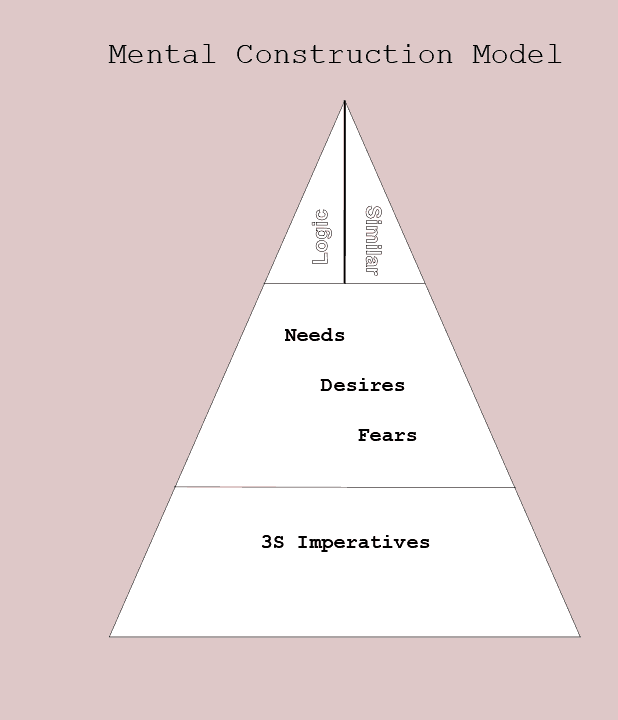The Mental Construction Model (on the left) displays the levels and relationships that our brain and mind use to handle daily life.
The term ‘mind’ is distinguished from ‘brain’ in this way. Brain refers to the physical neurons, connections, and local modules in our scull. Mind refers to the categories, concepts, associations, and relationships we use to form our understanding of the world from data incomplete. The data is incomplete because our unique position constrains our raw information, our neurons abstract that portion we perceive, and our grasp of the relationship between categories and concepts is inherently tentative.
Base. 3S Imperatives
Let’s start at the base of the pyramid in the Mental Construction Model, 3S Imperatives. Satisfaction of material needs (food, water, sugar level in blood, potassium and calcium balance, and so on) and Sexual urges are physical urges originating in the earliest organisms (exhibited in our ancient brainstems). Both imperatives continue to underlie broad swaths of our behaviors.
The pyramid base level roughly corresponds to using reflexes and instincts to respond to the world.
Middle Layer. Emotions and Desires
The third 3S Imperative, Safety (fight-or-flight), became a behavioral feature when organisms can remember and relate current situations to ones in the past. This required memory, a feature requiring the hippocampus in the limbic system. It doesn’t become fully functional in people until 3-5 years of age. One last point: the advances of civilization have made hunger manageable and danger relatively rare, implying that 3S Imperatives can be satisfied by many diverse choices in modern societies.
The middle layer–Needs, Desires, and Fears–are the psychological forms that the 3S Imperatives give rise to in the tradeoffs of daily life. For instance, we desire a good job. That desire doesn’t immediately satisfy our hunger, but it will lead to that. A good job also could increase our chance of satisfying our sexual imperative, although time devoted to the occupation may restrict the frequency of meeting potential mates. This demonstrates an important principle. A need, desire, or fear needn’t meet just one of our physical imperatives. A consequence is that a situation will usually not satisfy all our imperatives at once.
The middle layer is based primarily on the development of the limbic-like structures which support memory. That allows comparison of past results to be compared with current, similar possibilities.
Capstone. Logic and Association
The peak of cognition, it comes at the last and is predicated on the outputs of the lower levels, is split between logical and association. Logical is the word-based view of the world with actions-and-reactions connected deductively. Association is short-hand for another method of thinking, using similarities to inductively draw conclusions. Mammals use similarity, only. Logic always leads to a valid conclusion if we start from valid premises. However, often we don’t have the necessary information, then we must use inductive similarities. Induction incurs a price, sometimes our conclusions will be wrong.
In another post, I discuss two alternative mental processing models, the triune brain and dual process models.

